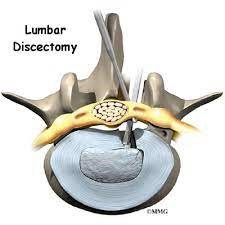Lumbar discectomy is a surgery to remove a herniated or degenerative disc in the lower spine. The incision is made posterior, through the back muscles, to remove the disc pressing on the nerve. Sometimes the outer wall of one of these discs may dry out and weaken with age or injury. When this happens, the soft, inner part of the disc bulges out. This is called a herniated or bulging disc. This bulging disc can press on the spinal cord and cause symptoms such as pain, tingling, or weakness in a nearby part of the body.
During a minimally invasive lumbar discectomy, an orthopedic surgeon takes out part of the damaged disc. This helps ease the pressure on the spinal cord. Your surgeon can use different methods to do this. With one method, your surgeon inserts a small tube through the skin on your back, between the vertebrae and into the space with the herniated disc. He or she then inserts tiny tools through the tube to remove a part of the disc. Or a laser may be used to remove part of the disc. Unlike an open lumbar discectomy, the surgeon makes only a very small skin incision and does not remove any bone or muscle.

Lumbar Micro discectomy Recovery Time
Most lumbar microdiscectomy patients are able to go home from the hospital a few hours after the surgery. The traditional approach to recovering from lumbar microdiscectomy has been to limit bending, lifting, or twisting for a minimum of 6 weeks in order to prevent the disc from herniating again.
While many doctors restrict too much activity for the first 6 weeks, limited research suggests that restricting activities for 2 weeks following lumbar microdiscectomy may be sufficient for many patients.
- Driving and light activities can typically be resumed after about 2 weeks.
- Routine activities, such as work, school, and/or hobbies may be resumed within 6 weeks.
- Strenuous labor or contact sports may be recommenced after 12 weeks or longer.
Pain and fatigue are typically severe during the first few days after a lumbar microdiscectomy. During the initial days at home, it is important for someone to be there to help with basics, such as cooking and household chores. If the patient lives alone, having a friend, relative, or hired aide to stay close can be of considerable help.
It is important to plan ahead and prepare alternatives to common daily activities before your surgery. Examples of specific activities that may be completed prior to surgery include shopping for groceries, running errands, taking care of household chores, such as doing laundry and changing bed sheets, etc. Keeping a multi-purpose grabber tool handy can be helpful to avoid reaching and bending movements after the surgery.
Factors That May Slow Down Recovery
Lumbar microdiscectomy surgery is less likely to be successful due to delayed healing caused by one or more of these factors :
- Too much activity, such as lifting heavy items or pushing through fatigue, may lead to increased pain or reinjury that requires additional treatment.
- Not caring for the incision site during the early recovery period and engaging in restricted activities, such as swimming or taking a bath, could cause the incision site to become infected.
- Staying sedentary and not walking enough can cause muscles to weaken further and prolong pain and stiffness following the surgery. Staying too sedentary may also contribute to problems with digestion, sleep, and/or mood. Most surgeons recommend taking short walks during the first few days following microdiscectomy surgery, then gradually build up from there.
- Not adhering to the medication plan can lead to inadequate pain relief, complications, and delayed recovery. If the prescribed medication is not working or causing side effects, ask the surgeon if there are any other options. It is important to let the surgeon know about all medications and supplements.
- Having diabetes or other chronic diseases may slow healing and recovery. Limited research suggests that people with diabetes are at an increased risk for complications following this procedure.